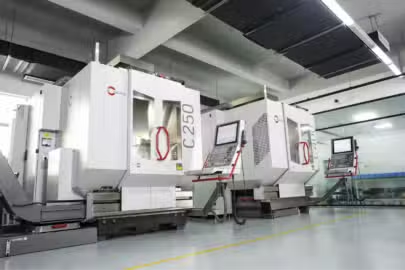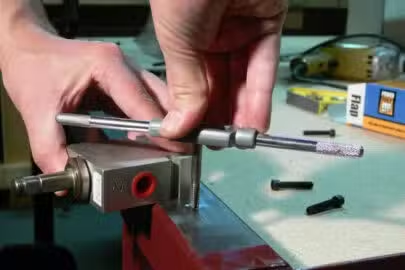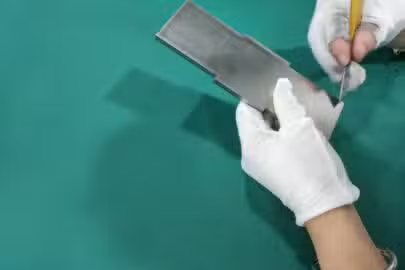Understanding the intricacies of CNC machining axes is important in product manufacturing. They have a crucial role in the operation of modern CNC machines, which predominantly use 4-axis and 5-axis configurations.
The main difference between 4-axis CNC machining and 5-axis CNC machining is the additional axes available. A 4-axis CNC machine has an extra A-axis, while a 5-axis CNC machine has two additional axes (A-axis and B-axis/C-axis, depending on the machine configuration).
This article aims to provide a comprehensive 4-axis CNC machining vs. 5-axis CNC machining comparison. It will cover fundamental principles, highlight key distinctions between them, and offer guidance on selecting the suitable configuration for your project.
What Is 4-Axis CNC Machining?
4-axis CNC machining builds upon the principles of 3-axis machining but introduces an additional rotational axis. In a 4-axis CNC machine, the spindle operates along three linear axes. This includes side-to-side, up-and-down, and back-and-forth movements. While this happens, the workpiece remains stationary on the machine table.
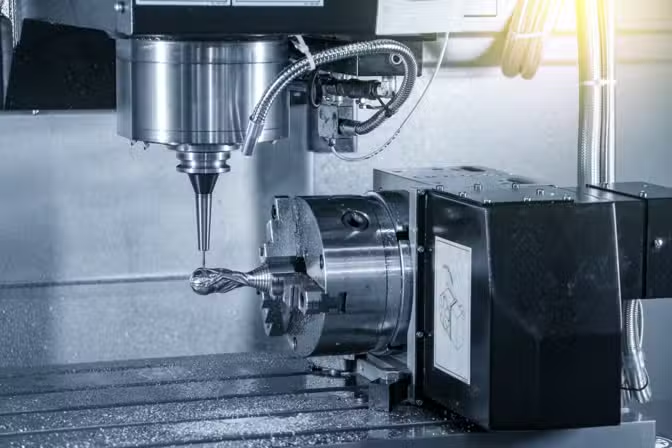
What sets 4-axis CNC machining apart is the introduction of a rotational axis known as the A-axis. The A-axis signifies the rotational movement about the X-axis. This additional axis permits 4-axis CNC machines to excel in tasks like hole drilling and cut-outs.
4-axis machines typically fall into the category of “vertical machining.” Here, the spindle rotates about the Z-axis. The workpiece is mounted along the X-axis and can rotate thanks to the fixture on the A-axis. This setup allows machining on four sides of the part with a single fixture, eliminating the need for frequent fixture changes and minimizing costs.
4-axis CNC machining comes in two variations:
- Indexing: In indexing 4-axis machining, the A-axis rotation occurs when the machine is not cutting material. The machine resumes cutting after the correct rotation is set.
- Continuous: Continuous 4-axis machining allows the machine to cut material while the A-axis is in motion. This capability is valuable for machining intricate profiles like helixes and cam lobes.
Pros and Cons of 4-Axis CNC Machining
Compared to the 3-axis machining process, a 4-axis CNC machining center offers several advantages. However, it also comes with some limitations. Let’s take a look at the benefits and drawbacks of this technique.
Pros
- Excellent multi-axis capabilities in a single setup
- Cost-efficient for large volumes
- High precision due to better control from the extra axis
- Enhanced capabilities for creating complex parts that are challenging with three axes
- Reduces production time without manual workpiece adjustments
- 4-axis CNC machines handle various materials and part sizes
Cons
- Higher initial investment
- Fixture expenses for basic single-face machining
- Reduced speed
- Geometry limitations compared to 5-axis CNC machines
When Should You Use 4-Axis CNC Machining?
4-axis CNC machines excel in the following:
- Machining curved surface features and angles centered around a single axis
- Multi-sided machining of workpieces featuring intricate features on multiple sides
- Meeting high tolerance requirements that surpass the capabilities of 3-axis CNC machines
- Efficient high-volume production
What Is 5-Axis CNC Machining?
A 5-axis CNC machining process resembles a 3-axis machining process but incorporates two additional essential features, offering greater cutting flexibility. In 5-axis CNC machining, the cutting tool and spindle move along three primary axes. There are added rotations along the X-axis (referred to as the A-axis), Y-axis (known as the B-axis), and Z-axis (referred to as the C-axis). The specific combination of rotational axes employed depends on the machine’s configuration.
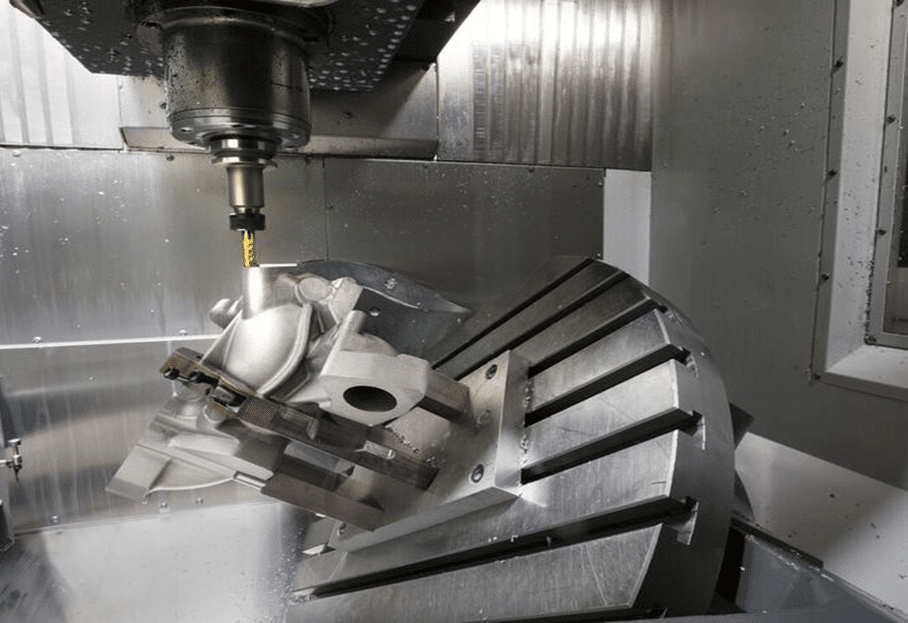
The choice of which rotational axes to use distinguishes the type of 5-axis CNC machining employed. It performs operations such as milling and turning, consolidating multiple functions into a single machine.
There are two major types of 5-axis CNC machines, including:
3+2-Axis CNC Machining
Sometimes referred to as positional 5-axis machining, this type bridges the gap between 3-axis and 5-axis processes. In this method, the cutting tool maintains a constant angle as the spindle or table rotates about the two extra axes. This ensures that the cutting tool is not always perpendicular to the part.
Indexed 3+2-axis machining is a modification of 3+2-axis machining. It allows manual adjustment of the cutting tool’s angle between cuts. This technique uses two rotational axes that operate independently. This allows the workpiece to be oriented at various compound angles in relation to the cutting tool, producing complex 3D shapes. However, it cannot rotate two axes simultaneously during machining, unlike fully continuous 5-axis machining.

Simultaneous 5-Axis CNC Machining
Continuous or simultaneous 5-axis machining occurs when the cutting tool remains perpendicular to the part throughout the operation. While it delivers superior surface finishes and access to challenging areas, it is generally slower than 3+2-axis machining. Simultaneous 5-axis machining excels at producing intricate shapes, including complex curved surfaces. This method enables the creation of components typically reserved for molding processes.
Pros and Cons of 5-Axis CNC Machining
5-axis CNC milling is a versatile technique that can produce components for several applications. While being efficient, it also has some downsides. Let’s examine the advantages and disadvantages
Pros
- 5-axis CNC machining handles intricate workpiece geometries
- Rapid production with fewer setups
- Precise parts machining with consistent quality
- Reduces machining time for complex workpieces
- Decreases reliance on fixtures and jigs for challenging areas
- More efficient material removal, especially on contoured surfaces
- High accuracy and superior surface quality
- Minimal risk of tool interference and tool wear
Cons
- Higher initial costs in comparison to 3-axis and 4-axis CNC machines, along with ongoing maintenance and operational expenses.
- Specialized operator training is necessary due to the complexity of 5-axis CNC machines.
- Complex programming is required due to the introduction of two additional variables.
When to Choose 5-Axis CNC Machining?

5-axis CNC machining is suitable for:
- Machining complex shapes effectively
- Handling high production volumes, reducing costs per part in large quantities
- Manufacturing precision parts in industries such as R&D, medical, aerospace, automotive, etc.
- Multi-side machining of parts with features on every face
4-Axis CNC Machining vs. 5-Axis CNC Machining: What Are the Differences?
The main difference between 4-axis and 5-axis CNC machining is the additional axes available. This is the catalyst for other differences between them, including:
Working Principle
CNC machines share a common working principle, where a Computer Numerically Controlled cutting tool rotates around the workpiece to perform cuts. G-Codes or M-Codes command the tool’s movement in relation to the workpiece. The distinction between 4-axis and 5-axis machines lies in their ability to rotate about different planes. Both 4-axis and 5-axis CNC machines enable movement along an additional axis, facilitating the machining of complex shapes and geometries.

A 4-axis CNC machine has an extra A-axis, while a 5-axis CNC machine has two additional axes (A-axis and B-axis/C-axis, depending on configuration). 4-axis CNC machining permits rotation on the A-axis. On the other hand, the 5th axis allows rotation on two of the three additional axes. The number of axes of movement is the key distinguishing factor between 4-axis and 5-axis CNC machining. It defines the direction the cutting tool can move, with 5-axis CNC machining offering the highest degree of cutting tool movement.
Accuracy and Precision
CNC machining is known for its high accuracy and tight tolerances. In 3-axis CNC machining, the frequent repositioning of the workpiece can introduce the potential for errors. Conversely, 4- and 5-axis machines typically exhibit fewer deviations than 3-axis machining because they do not require repositioning.

These machines can efficiently add features to a workpiece on multiple planes or positions with a single fixture. However, 5-axis milling offers greater precision accuracy than the 4-axis counterpart. Therefore, it is preferred for applications with high-tolerance requirements, like in the medical or aerospace industry.
Flexibility
5-axis CNC machining differs from 4-axis CNC machining by having an additional, non-localized axis. In 4-axis CNC machining, the extra axis is always on the X-axis. On the other hand, the extra axis can be on two of the XYZ axes in 5-axis CNC machining. This non-localized extra axis grants 5-axis machining greater flexibility over 4-axis machining.
Lead Time
5-axis machines excel in minimizing lead time due to their faster operation. This efficiency stems from the simultaneous use of multiple cutting tools. In contrast, 4-axis CNC machines generally require more time to complete a task compared to 5-axis machines. This makes them less time-efficient for certain operations.
Applications
5-axis CNC machines find diverse applications in several industries:
- Aerospace: Used for crafting complex shapes and precise components in aero-engine and airframe manufacturing.
- Automotive: Employed in producing prototypes, engine components, and intricate custom parts.
- Medical: Valuable in creating orthopedic implants like hip and knee replacements, meeting the demand for complex and organic shapes.
- Energy: Vital for crafting turbine components, particularly in wind turbines, ensuring optimal efficiency through precision parts.

4-axis CNC machines also play a significant role in various sectors:
- Aerospace: They are favored for their precision in manufacturing intricate parts like turbine and airframe components.
- Automotive: Used extensively for producing engine components and body parts efficiently.
- Electronics: Trusted for crafting precise electronic components, including circuit boards and casings.
- Oil and Gas: Utilized to create robust, high-quality components capable of withstanding extreme conditions.
Cost
The enhanced features and capabilities of 5-axis CNC machining contribute to its higher cost when compared to 4-axis CNC machining. Generally, 4-axis machines are more cost-effective for initial purchase and maintenance than 5-axis machines. Nevertheless, operational costs can vary depending on factors such as operator availability. While both 4- and 5-axis machines are more expensive upfront, they offer advanced capabilities that justify their cost. This is especially the case when tackling unique and demanding tasks.
Here’s a table summarizing the differences between 4-axis CNC machining and 5-axis CNC machining:
| Aspect | 4-Axis CNC Machining | 5-Axis CNC Machining |
| Number of Axes | Four axes (X, Y, Z, A) | Five axes (X, Y, Z, A, B/C) |
| Working Principle | The spindle moves on four axes. | The spindle moves on five axes. |
| Precision and Accuracy | Generally precise; requires some repositioning. | High precision with minimal repositioning. |
| Flexibility | The extra axis is always on the X-axis. | Extra axes on two of the XYZ axes. |
| Lead Time | Usually requires more time. | Minimizes lead time due to faster operation. |
| Applications | Suitable for small and simple projects. | Ideal for complex, high-precision parts. |
| Cost | Generally more cost-effective. | More expensive upfront but offers advanced capabilities. |
| Production Volume | Suitable for low-volume manufacturing. | More ideal for high-volume production. |
| Part Complexity | Handles basic to moderately complex parts. | Suited for intricate parts with complex geometries. |
Considerations for Choosing Between 4-Axis and 5-Axis CNC Machining
The advantages of 4-axis and 5-axis machining include enhanced part access, rapid manufacturing, reduced tool wear, faster setup times, and superb surface finishes.

When choosing between these options, these crucial factors come into play:
Budget
In general, the cost of 5-axis CNC machining surpasses that of 4-axis CNC machining due to increased complexity, functionality, and precision. For budget-conscious projects, 4-axis CNC machining offers added detail at a moderate cost. On the budget scale, 5-axis machining ranks as the most expensive, followed by 4-axis, corresponding to their increasing capability, functions, and features.
Machining Requirements and Operating Procedures
Complex parts benefit from 5-axis CNC machining, while 4-axis are suitable for small and simple projects. The number of axes corresponds to the complexity of the operation, with the 4-axis being simpler than the 5-axis. Machine compatibility may limit your axis choices, e.g., vertical milling machines typically have 3-axis movement. A 4-axis CNC milling machine often comes with a rotary table. 5-axis machining streamlines production but entails a more complex operating procedure.
Part Complexity
For small and uncomplicated parts, 5-axis CNC machines are unnecessary.4-axis machining is usually more than capable of handling basic to moderately complex parts. A 4-axis CNC lathe machine is proficient at machining multiple flat components, curved features, and parts that require minimal clearance. On the other hand, 5-axis CNC machined parts often come with intricate shapes, complex geometries, tight tolerances, and larger dimensions.
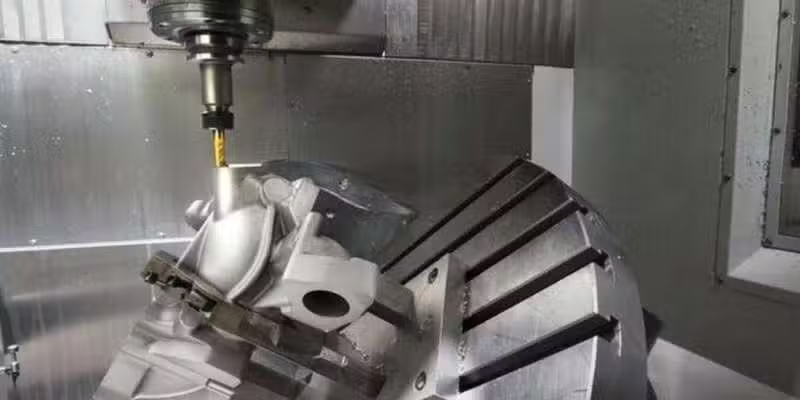
Production Volume
The choice of the machining process should also be influenced by the production volume you intend to achieve. 4-axis machining can meet low-volume production needs. However, for high-volume production, the 5-axis option becomes more suitable.
Lead Time
4-axis CNC machines generally offer quicker setup times and are easier to use. However, 5-axis machining can save you more time in the long run. It eliminates the need for assembly and can deliver your components within a single setup.
Application
Aerospace, medical, defense, and precision parts demand ultra-high precision. These applications are most achievable through multi-axis machining like 5-axis. 4-axis machining can also help with these applications but at a lower efficiency than the 5-axis production process.
Get Reliable Multi-Axis CNC Machining Services at Zintilon
If you need top-notch CNC machining services for your projects, ZINTILON is an excellent choice for reliable multi-axis machining. Our CNC machine shop boasts advanced multi-axis machines that meet your project’s unique needs.

What sets us apart even further is our team of seasoned professionals, ready to guide every stage of your project. This support helps minimize the potential for issues in programming, machining, or post-processing. We also provide various post-machining and Surface finishing services to enhance your products’ functionality and aesthetics. Don’t hesitate to contact us today to discuss your upcoming project.
Conclusion
Understanding the differences between 4-axis and 5-axis CNC machining is a vital step in the manufacturing process. This is particularly important because both 4-axis and 5-axis CNC machining processes are widely used in custom manufacturing. Thus, this article has broken down the distinction between these two approaches.
If you’re considering implementing either of these methods in your project, ZINTILON is your best bet. Our team of experts is adequately experienced in CNC machining, ensuring the delivery of top-quality products customized to your precise specifications. Get a quote today!


